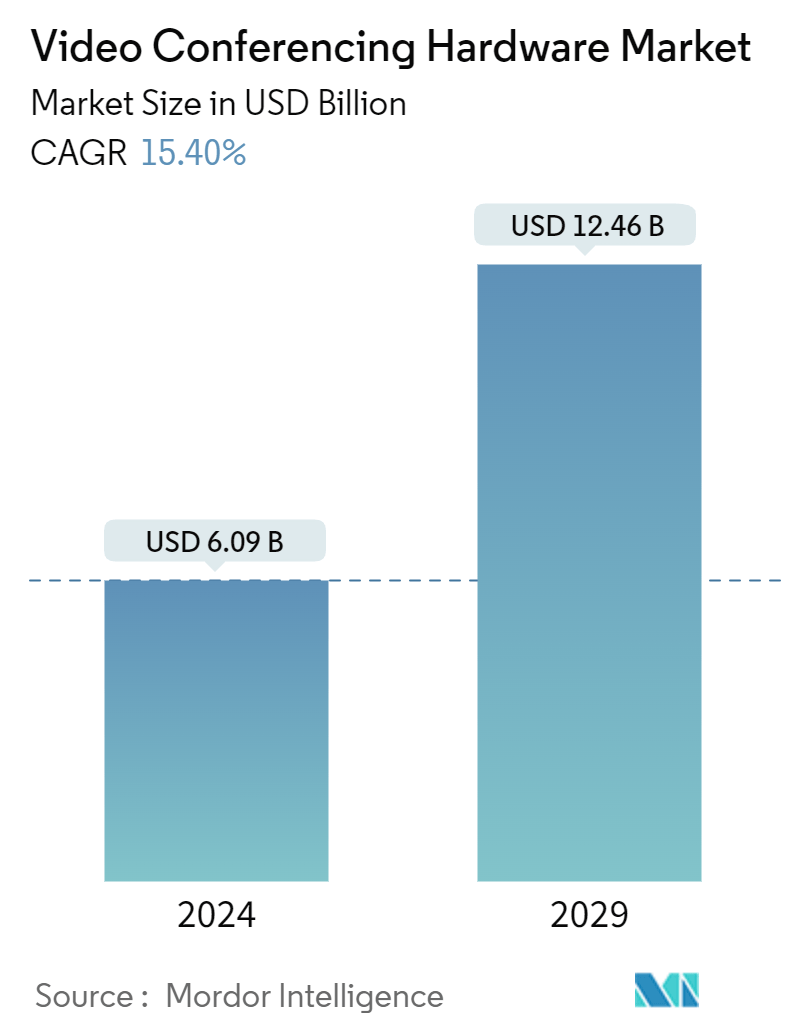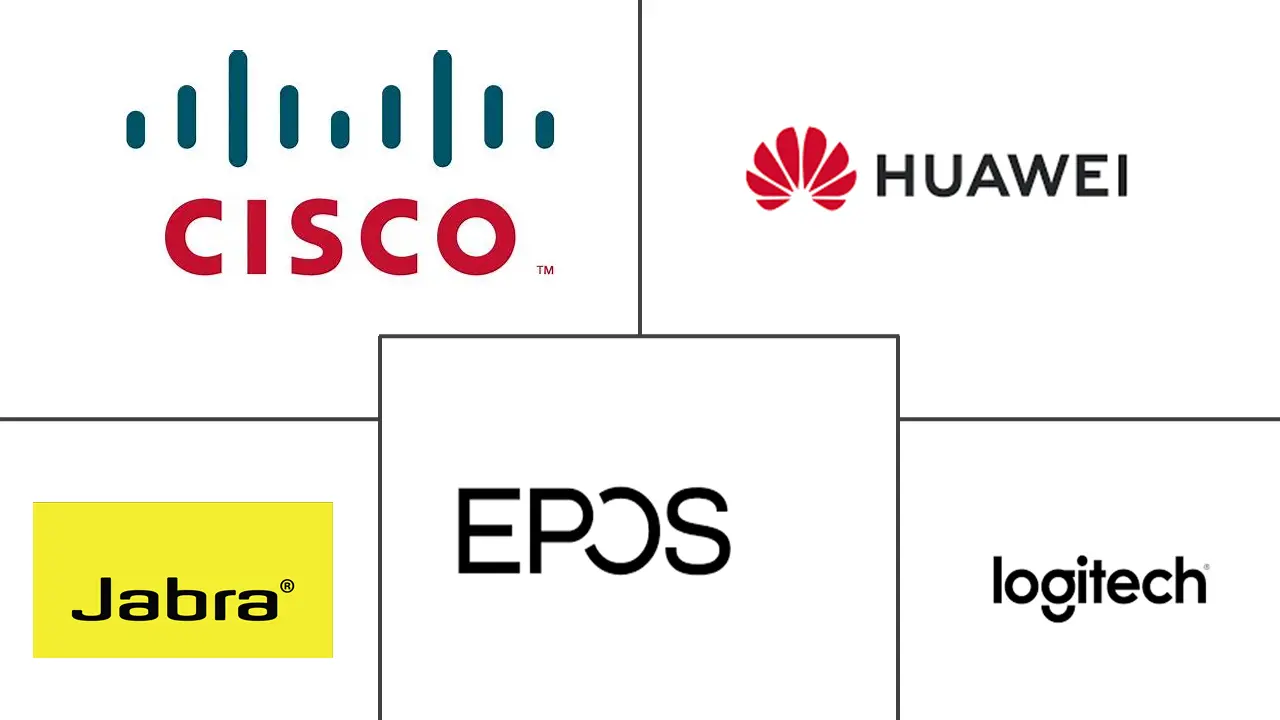Market Size of Video Conferencing Hardware Industry

| Study Period | 2019 - 2029 |
| Market Size (2024) | USD 6.09 Billion |
| Market Size (2029) | USD 12.46 Billion |
| CAGR (2024 - 2029) | 15.40 % |
| Fastest Growing Market | Asia Pacific |
| Largest Market | North America |
Major Players
*Disclaimer: Major Players sorted in no particular order |
Video Conferencing Hardware Market Analysis
The Video Conferencing Hardware Market size is estimated at USD 6.09 billion in 2024, and is expected to reach USD 12.46 billion by 2029, growing at a CAGR of 15.40% during the forecast period (2024-2029).
- Video conferencing has become an essential tool in modern communication, connecting individuals and businesses worldwide. Its importance extends beyond everyday meetings and impacts sectors such as institutional and commercial spaces.
- As remote work plans become increasingly accepted due to factors such as globalization and mechanical capacity, interest in video conferencing hardware is growing. Organizations of various businesses conduct virtual meetings, collaborative work, and correspondence through video conferencing.
- Moreover, hybrid work models that combine remote and in-person work are becoming increasingly popular as the workforce embraces flexibility and autonomy. This trend requires a video conferencing solution that seamlessly connects remote and on-site employees to enable productive collaboration regardless of physical location. As organizations transition to hybrid work environments, there is a high demand for video conferencing hardware that offers features including virtual meeting rooms, screen sharing, and mobile accessibility, thus driving the demand for the video conferencing hardware market.
- With the proliferation of high-speed internet and the wide spread of laptops, tablets, and smartphones, video conferencing has become an indispensable communication solution for enterprises, offices, and individuals globally. Furthermore, according to the National Bureau of Statistics of China, during January/February of 2024, the production value of finished computers in China stood at 45.45 million units.
- Limited communication infrastructure in emerging and underdeveloped nations hinders high-quality video transmission. Thus, the lack of a strong communication infrastructure represents a significant challenge for the video conferencing hardware market.
- Macroeconomic factors such as government regulation on the import/export of video conferencing hardware products can significantly impact the market's growth. These regulations vary from country to country, often requiring extensive certifications, testing, and adherence to specific standards. While these regulations aim to ensure safety and quality, they can pose significant challenges for manufacturers, distributors, and end-users.
Video Conferencing Hardware Industry Segmentation
The study tracks the revenue accrued through the sale of video conferencing hardware by various players in the global market. The study also tracks the key market parameters, underlying growth influencers, and major vendors operating in the industry, which supports the market estimations and growth rates over the forecast period. The study further analyses the overall impact of COVID-19 aftereffects and other macroeconomic factors on the market. The report’s scope encompasses market sizing and forecasts for various market segments.
The video conferencing hardware market is segmented by type of hardware (multi-control units, collaboration bars, codec systems, USB cameras, USB-based integrated bars, other bundled kits, and enterprise headsets), by end-user (institutions and commercial spaces), and geography (North America (United States, Canada), Europe (United Kingdom, Germany, France, Italy, and Rest of Europe), Asia-Pacific (China, Japan, India, South Korea, and Rest of Asia-Pacific), Latin America (Brazil, Argentina, Mexico, and Rest of Latin America), and Middle East & Africa (South Africa, United Arab Emirates, Saudi Arabia, and Rest of Middle East & Africa)). The market sizes and forecasts are provided in terms of value (USD) for all the above segments.
| By Type of Hardware | |
| Multi Control Units (MCU) | |
| Collaboration Bars | |
| Codec Systems | |
| USB Cameras | |
| USB-based Interagted Bars | |
| Other Bundled Kits | |
| Enterprise Headsets |
| By End User | |
| Institutions | |
| Commercial Spaces |
| By Geography*** | ||||||
| ||||||
| ||||||
| ||||||
| Australia and New Zealand | ||||||
| ||||||
|
Video Conferencing Hardware Market Size Summary
The video conferencing hardware market is experiencing significant growth, driven by the increasing adoption of remote and hybrid work models. As businesses and individuals seek effective communication solutions, video conferencing has become a crucial tool for facilitating virtual meetings, collaboration, and real-time communication across geographically dispersed teams. The demand for hardware that supports features like virtual meeting rooms, screen sharing, and mobile accessibility is on the rise, as organizations strive to enhance productivity and maintain connectivity among remote and on-site employees. This trend is further supported by the proliferation of high-speed internet and the widespread use of devices such as laptops, tablets, and smartphones, which have made video conferencing an indispensable communication solution globally.
In North America, the demand for video conferencing hardware is particularly strong due to well-established internet infrastructure and the rapid development of 5G networks, which promise faster speeds and improved video quality. The region's cultural shift towards flexible working arrangements and the need for cost-effective communication platforms have accelerated market growth. Major players in the market are focusing on innovation and strategic collaborations to expand their customer base and enhance their product offerings. The market is characterized by high competition, with key players like Cisco System Inc., Logitech International SA, and Huawei Technologies Co. Ltd. leading the charge in providing advanced video conferencing solutions. As the market continues to evolve, opportunities for innovation and expansion remain abundant, particularly in regions with robust technological infrastructure.
Video Conferencing Hardware Market Size - Table of Contents
-
1. MARKET INSIGHTS
-
1.1 Market Overview
-
1.2 Industry Attractiveness - Porter's Five Forces Analysis
-
1.2.1 Threat of New Entrants
-
1.2.2 Bargaining Power of Buyers/Consumers
-
1.2.3 Bargaining Power of Suppliers
-
1.2.4 Threat of Substitute Products
-
1.2.5 Intensity of Competitive Rivalry
-
-
1.3 Industry Value Chain
-
1.4 Impact of COVID-19 Aftereffects and Other Macroeconomic Factors on the Market
-
-
2. MARKET SEGMENTATION
-
2.1 By Type of Hardware
-
2.1.1 Multi Control Units (MCU)
-
2.1.2 Collaboration Bars
-
2.1.3 Codec Systems
-
2.1.4 USB Cameras
-
2.1.5 USB-based Interagted Bars
-
2.1.6 Other Bundled Kits
-
2.1.7 Enterprise Headsets
-
-
2.2 By End User
-
2.2.1 Institutions
-
2.2.2 Commercial Spaces
-
-
2.3 By Geography***
-
2.3.1 North America
-
2.3.1.1 United States
-
2.3.1.2 Canada
-
-
2.3.2 Europe
-
2.3.2.1 United Kingdom
-
2.3.2.2 Germany
-
2.3.2.3 France
-
2.3.2.4 Italy
-
-
2.3.3 Asia
-
2.3.3.1 China
-
2.3.3.2 Japan
-
2.3.3.3 India
-
2.3.3.4 South Korea
-
-
2.3.4 Australia and New Zealand
-
2.3.5 Latin America
-
2.3.5.1 Brazil
-
2.3.5.2 Argentina
-
2.3.5.3 Mexico
-
-
2.3.6 Middle East and Africa
-
2.3.6.1 South Africa
-
2.3.6.2 United Arab Emirates
-
2.3.6.3 Saudi Arabia
-
-
-
Video Conferencing Hardware Market Size FAQs
How big is the Video Conferencing Hardware Market?
The Video Conferencing Hardware Market size is expected to reach USD 6.09 billion in 2024 and grow at a CAGR of 15.40% to reach USD 12.46 billion by 2029.
What is the current Video Conferencing Hardware Market size?
In 2024, the Video Conferencing Hardware Market size is expected to reach USD 6.09 billion.

